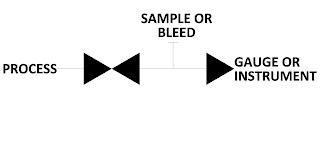 |
| Gauge Root Valve, a type of instrument valve Courtesy Mac-Weld |
When selecting an instrument valve, consider construction materials that are compatible with the process media. Additionally, operating temperature and pressure of the process must be well within the limits of the valve.
Instrument needle valves provide reliable function to throttle, regulate and isolate gaseous and aggressive non-viscous liquid services. Product offerings range from simple two-way isolation valves to multiport gauge root valves providing multifunction capability to isolate, calibrate and vent gauge, pressure switches and static instrument applications. Ball valves in this class do not provide the throttling accuracy of a needle valve, but may provide some advantage with the use of certain media. The ball valve design, with its full size port, enables easier cleaning and a lessened potential for clogging.
There are three basic configurations of instrument valves. The simplest is the isolation valve with a single inlet and outlet. It provides for selection of exposure or isolation of a connected gauge or other device to the operating process piping or vessel. Maintenance or replacement of the connected device can be effected without opening the contained process to the surrounding environment.
A second variant of instrument valves performs the function of an isolation valve, but has an added port on the outlet side (the side where a gauge or instrument would be connected). The added function of the port is to provide connection access for service, calibration, sampling, purging, or a host of other tasks, all of which can be completed while the process remains in operation.
The third form of instrument valve is a multi-port valve with a single inlet and three outlets. It is often called a "gauge root valve" and serves a number of purposes with its multiple outlet connections. Sometimes two of the ports will be plugged and the instrument or gauge connected to the port providing the most convenient or functional orientation of the connected gauge or the valve handle. This valve can also enable a wide variety of applications through connection of additional instruments, gauges, valves, or other equipment.
 |
| Schematic representation of block and bleed valve |
 |
| Schematic representation of gauge root valve |
Share your process measurement and control instrumentation and gauge challenges with application experts and benefit from their expertise.






